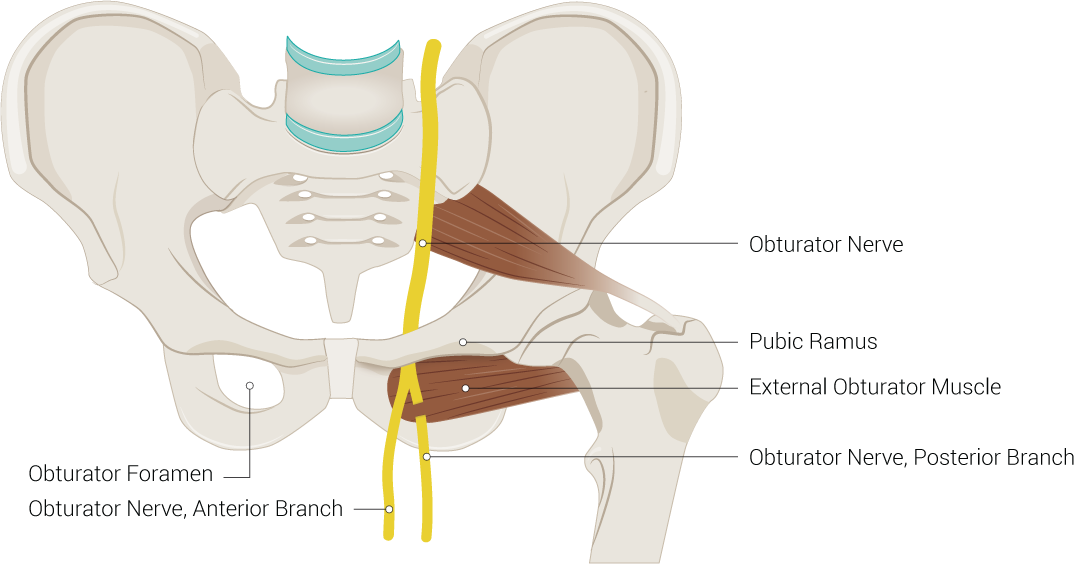[2]
Khan IA, Bordoni B, Varacallo M. Anatomy, Bony Pelvis and Lower Limb: Thigh Gracilis Muscle. StatPearls. 2023 Jan:():
[PubMed PMID: 30855817]
[3]
Yoshida T, Nakamoto T, Kamibayashi T. Ultrasound-Guided Obturator Nerve Block: A Focused Review on Anatomy and Updated Techniques. BioMed research international. 2017:2017():7023750. doi: 10.1155/2017/7023750. Epub 2017 Feb 9
[PubMed PMID: 28280738]
[4]
Anagnostopoulou S, Kostopanagiotou G, Paraskeuopoulos T, Chantzi C, Lolis E, Saranteas T. Anatomic variations of the obturator nerve in the inguinal region: implications in conventional and ultrasound regional anesthesia techniques. Regional anesthesia and pain medicine. 2009 Jan-Feb:34(1):33-9. doi: 10.1097/AAP.0b013e3181933b51. Epub
[PubMed PMID: 19258986]
[5]
Bouaziz H, Vial F, Jochum D, Macalou D, Heck M, Meuret P, Braun M, Laxenaire MC. An evaluation of the cutaneous distribution after obturator nerve block. Anesthesia and analgesia. 2002 Feb:94(2):445-9, table of contents
[PubMed PMID: 11812716]
[6]
De Decker A, Fergusson R, Ondruschka B, Hammer N, Zwirner J. Anatomical structures at risk using different approaches for sacrospinous ligament fixation. Clinical anatomy (New York, N.Y.). 2020 May:33(4):522-529. doi: 10.1002/ca.23404. Epub 2019 May 29
[PubMed PMID: 31087424]
[7]
Menderes G, Vilardo N, Schwab CL, Azodi M. Incidental injury and repair of obturator nerve during laparoscopic pelvic lymphadenectomy. Gynecologic oncology. 2016 Jul:142(1):208. doi: 10.1016/j.ygyno.2016.05.023. Epub 2016 May 27
[PubMed PMID: 27234143]
[8]
Aydogmus S, Kelekci S, Aydogmus H, Ekmekci E, Secil Y, Ture S. Obturator Nerve Injury: An Infrequent Complication of TOT Procedure. Case reports in obstetrics and gynecology. 2014:2014():290382. doi: 10.1155/2014/290382. Epub 2014 Sep 29
[PubMed PMID: 25343052]
Level 3 (low-level) evidence
[9]
Panagoda PI, Vasdev N, Gowrie-Mohan S. Avoiding the Obturator Jerk during TURBT. Current urology. 2018 Oct:12(1):1-5. doi: 10.1159/000447223. Epub 2018 Jun 30
[PubMed PMID: 30374273]
[10]
Kawaguchi M, Hashizume K, Iwata T, Furuya H. Percutaneous radiofrequency lesioning of sensory branches of the obturator and femoral nerves for the treatment of hip joint pain. Regional anesthesia and pain medicine. 2001 Nov-Dec:26(6):576-81
[PubMed PMID: 11707799]
[11]
Kulkarni SR, Punamiya AR, Naniwadekar RG, Janugade HB, Chotai TD, Vimal Singh T, Natchair A. Obturator hernia: A diagnostic challenge. International journal of surgery case reports. 2013:4(7):606-8. doi: 10.1016/j.ijscr.2013.02.023. Epub 2013 Apr 17
[PubMed PMID: 23708307]
Level 3 (low-level) evidence
[12]
Martin R, Martin HD, Kivlan BR. NERVE ENTRAPMENT IN THE HIP REGION: CURRENT CONCEPTS REVIEW. International journal of sports physical therapy. 2017 Dec:12(7):1163-1173
[PubMed PMID: 29234567]
[13]
Bradshaw C, McCrory P, Bell S, Brukner P. Obturator nerve entrapment. A cause of groin pain in athletes. The American journal of sports medicine. 1997 May-Jun:25(3):402-8
[PubMed PMID: 9167824]


